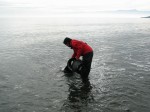All articles and posts on the MetchosinCoastal website under the title Forage Fish may be found here:
In 2008 and in 2013, Ramona de Graaf, a biologist with the Public Education Program at the Bamfield Marine Station gave presentations on Forage Fish on our beaches and the need to Document their occurrence. In 2008 on the Saturday after the presentation, we rejoined for a walk and a session on the process involved in sampling for Forage Fish on Taylor Beach. Ramona is also the principal and founding marine scientist of Emerald Sea Research and Consulting.
- A group of Metchosinites go to Taylor Beach for a demonstration of beach sampling for forage fish eggs .
- A 30 metre line is laid out a metre below the strand line
- Ramona checking for sand lance egg locations
- mall trowel samples are taken of the pea gravel. Several samples make a collection to be examined.
- A set of sieves which can be home-made like these are used to sort the sand.
- The end sample in the .5mm sieve will be examined with a microscope.
- Small eggs of the forage fish roll on the sand surface.
- Wen-Ling Liao cleaning equipment after sampling.
Our thanks from the Blue-Green Spaces committee to Ramona and Wen-Ling for this informative session on the importance of monitoring and preserving forage fish habitat.
See also the post: Overhanging Vegetation, Invertebrates and Forage fish
See also Forage Fish of Metchosin and Beyond by Moralea Milne with an article by Briony Penn : The herring, the Chinook and the Orca…At the Brink. Moralea also documents a second training session by Ramona on Taylor Beach in March of 2009. Inclued is an article she wrote for the January Issue of The Metchosin Muse.
Throughout the Strait of Georgia, fish stocks have dramatically declined. Lingcod, rockfish and some Pacific salmon species are only some of the major commercial fish species in decline. Seabird populations throughout British Columbia and Washington State are also decreasing. As well, marine species such as the southern resident killer whale, dependent on salmon runs, have been listed as endangered. Many of these species depend on bait or ?forage? fishes as prey. Spawning habitat of forage fishes is located in nearshore marine environments, an environment heavily impacted by human development.
Documenting and protecting forage fish spawning habitats must be a priority for the Metchosin Coastline.
There is little information on the current extent and health of the spawning habitats of herring and no information on the spawning habitat of surf smelt and Pacific sand lance. Surf smelt and sand lance spawn in gravel/sand beach habitats in the upper one third of the intertidal zone (Figure 1). Current spawning habitats of surf smelt and sand lance have been documented throughout the US coasts of the Juan de Fuca Strait, San Juan Islands, and Puget Sound (Penttila 2000, 2001). In Canada, eelgrass beds are protected as critical fish habitat under Fisheries and Oceans Canada ?no-net? loss policy (Federal Fisheries Act). Protecting forage fish spawning and rearing habitats will have positive benefits by protecting a vital food source for numerous marine predators. Fisheries and Oceans Canada recognizes the need to obtain information on the habitat requirements of forage fishes in Coastal areas.
| Intertidal zone spawning locations. |
| WHAT ARE WE CONCERNED ABOUT WITH METCHOSIN’S BEACHES?
Diversion of sediment-bearing streams through culverts, and the backshore and intertidal placement of seawalls, outfall pipes and riprap armouring interrupt natural coastal processes (such as erosion) that supply terrestrially-borne gravel sediments to beaches crucial to spawning surf smelt and Pacific sand lance. Seawalls are physical barriers that block the seaward transport of eroding gravels from feeder bluffs. Impediment of the long-shore transport of sediments by groins, outflow pipes, piers, boat ramps and docks have all contributed to the sediment-starved state of some beach faces. In general, the placement of seawalls and riprap armouring in the backshore and in the intertidal continues the process of sediment deprivation due to the action of wave scouring. Wave scouring can result in the loss of fine sands and gravels (appropriate for spawning) and the dominance of coarser (larger) gravels and cobble beaches inappropriate for use as spawning gravels for both surf smelt and Pacific sand lance. Seawalls such as those onPreliminary Habitat Assessment for suitability of intertidally spawning forage fish species, Pacific sand lance (Ammodytes hexapterus) and surf smelt (Hypomesus pretiosus) Esquimalt Lagoon, Colwood , British Columbia and Tower Point are often placed in the backshore, supralittoral and high intertidal zones (the uppermost portion of the high tide range) which can result in the loss of spawning habitat area, a decrease in beach elevation, an increase in beach slope, interruption of the sediment-transport drift cell, and the loss of sediment retaining logs. Not only are these ?hard? approaches to storm protection negatively impacting forage fish populations, but they can fail to deliver the protection intended. Around the world and locally, there are growing incidences of seawalls and other armouring failing to protect land owners. Modern engineering approaches, or ?soft? approaches work with coastal processes to provide safety for human populations and industries as well as maintaining marine ecological functions. While this report will not address this topic in detail, several informative websites and consultants include http://www.greenshores.ca, http://www.coastalgeo.com, and http:// www.sanjuans.org.
Googlethe PDF : Preliminary Habitat Assessment for suitability of intertidally spawning forage fish species, Pacific sand lance (Ammodytes hexapterus) and surf smelt (Hypomesus pretiosus) Esquimalt Lagoon, Colwood , British Columbia |






















